Pierre Plantard
The Traditionalist Roman Catholic
Antithesis of Freemasonry
Paul Smith
2005
Revised 27 July 2017
When the Priory of Sion was originally founded in 1956 it bore the acronym CIRCUIT that stood for Chevalerie d'Institution et Règle Catholique & d'Union Indépendante Traditionaliste (Chivalry of Catholic Rules and Institution of Independent Traditionalist Union) – the Statutes of the Priory of Sion resembled the earlier wartime Statutes of the Alpha Galates: a phantom quasi-occult, anti-masonic/anti-semitic, pro-Vichyite association, whereby membership was closed to Jews (Article 7).
The 1956 version of the Priory of Sion terminated the same year it was founded and had nothing to do with the Crusades, Godfrey de Bouillon, Merovingians, the Knights Templar or with the village of Rennes-le-Château – these elements were all added later when Pierre Plantard formed a partnership with Gérard de Sède during the early 1960s, representing a book-selling deal between the two people.
Les Dossiers Secrets d'Henri Lobineau presented significance between Pope John XXIII (Angelo Giuseppe Roncalli, 1881-1963) and Jean Cocteau (1889-1963), the last fictional Grand Master of the fictional Priory of Sion (before Pierre Plantard changed the history of the Priory of Sion during the 1980s and introduced a new Grand Master List, making Jean-Tim Negri d'Ables the new founder).

The Grand Master List of Les Dossiers Secrets compared the tenure of Jean Cocteau, who bore the title Jean XXIII – with the Papacy of John XXIII. Jean Cocteau returned to the Roman Catholic Church on 18 June 1925 and received Holy Communion on 19 June, Feast Day of the Sacred Heart.
Cocteau described his return to the Catholic Church in a letter to Jacques Maritain (1882-1973), published into English in Art and Faith: Letters Between Jacques Maritain and Jean Cocteau (Philosophical Library, 1948; first published in France in 1926).
Cocteau also wrote an unpublished poem in around 1925 called “son coeur rouge et or” that represented the importance of the sacred or red heart.
While Jean Cocteau symbolised the return of the “Prodigal Son” to the Roman Catholic Church, Pope Jean XXIII symbolised the apostate who convened the Second Vatican Council that debased the values of the Roman Catholic Church.
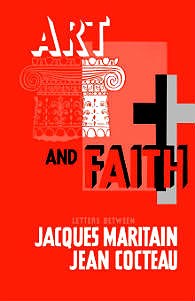
The Fifth French Republic commenced in 1958 and Plantard believed that the Age of Aquarius also commenced in 1958 (calculated from Julius Caesar’s crossing of the Rubicon River in 49 BC, which was the Age of Pisces, and 1958 was the Age of Aquarius; from Gisors et son secret..., deposition date in Bibliothèque Nationale, 15 December 1961).

Pope John XXIII convened the Second Vatican Council between 1962-1965 – whereby the Jews were exonerated from having any blame for the death of Jesus Christ and the ceremony of the Mass in Latin was abolished.
But Pierre Plantard and Philippe de Chérisey rejected the tenure of Pope John XXIII because of the Second Vatican Council.
Monsignor Marcel Lefebvre (1905-1991) and the Abbé Georges de Nantes (1924-2010) both virulently opposed Vatican Two and rejected whoever occupied The Holy See after Pope Pius XII (Eugenio Maria Giuseppe Giovanni Pacelli, 1876-1958) – called Sedevacantism.
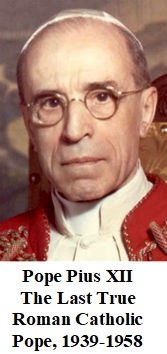
Marcel Lefebvre and Georges de Nantes were both excommunicated by the Vatican. Georges de Nantes formed the Catholic Counter-Reformation Movement (Ligue de la contre-réforme catholique, or CRC) in 1967. Marcel Lefebvre founded the Society of Saint Pius X (SSPX) in 1970, which he regarded as a sign of Divine Providence (God’s intervention in the world).
Marcel Lefebvre was dubbed the Grand Master of the Priory of Sion in Le Cercle d'Ulysse (1977) and an article in Les Dossiers Secrets d'Henri Lobineau claimed that Serge Roux was in fact the Abbé Georges de Nantes.
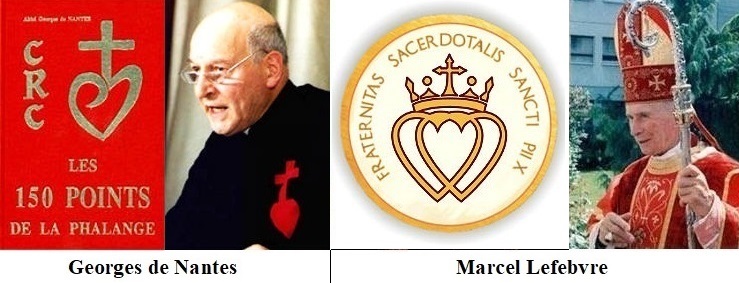
The insertion of Jean Cocteau into the Grand Masters List of Les Dossiers Secrets was also based partly on Philippe de Chèrisey's suggestion, because of his interest in surrealism. But there was no “Surrealist significance” to one of the names added by Pierre Plantard – the last mural to be executed by Jean Cocteau was left unfinished and it featured the anti-Semitic hero of the First Crusade, Godfrey de Bouillon (1060-1100) – the founder of the Priory of Sion.
Pierre Plantard claimed to have communicated with the spirit of Godfrey de Bouillon in séances, according to those who were close to him.
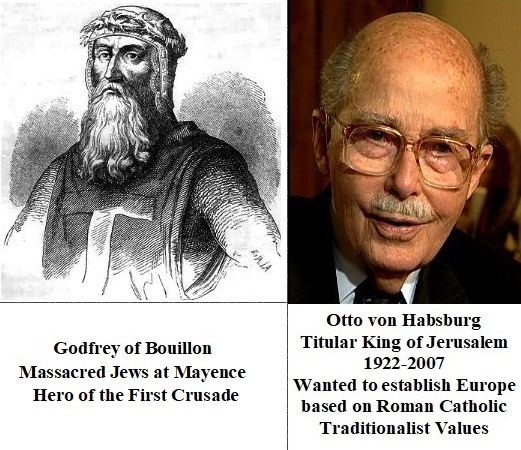
Piers Compton (1901-1986)
The conspiracy theorist Piers Compton claimed that Pope John XXIII was a Rosicrucian in his 1981 book The Broken Cross: The Hidden Hand In The Vatican (Part 3). This was taken from Le profezie di Papa Giovanni by “Pier Carpi” (pseudonym), Edizioni Mediterranee, Roma, 1976.
Compton’s book bears all the hallmarks of the language and stance used by Traditionalist Roman Catholics against Vatican Two and how Freemasonry allegedly regarded Pope John XXIII as a hero.
Piers Compton was a former Catholic priest and Literary Editor of the Catholic Weekly The Universe for 14 years.
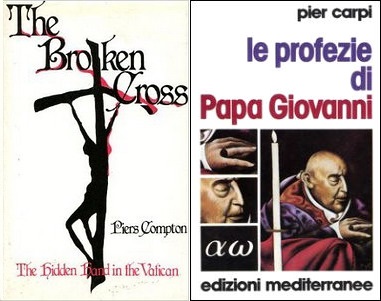
Malachi Martin (1921-1999)
Malachi Martin claimed Freemasons existed within the Vatican in his 1986 novel, Vatican (Popes John XXIII and Paul VI, and had photographic proof). He also claimed that Satanism existed in the Vatican in his 1991 book The Keys of This Blood. Again, his books contain the hallmarks of a Roman Catholic who was against Vatican Two.
Originally a Jesuit priest, Malachi Martin asked to be released from some of his Jesuit vows following his initial involvement in Vatican Two, and later wrote books attacking the Roman Catholic Church.
Malachi Martin was a believer in the Three Secrets of Fátima.

|







